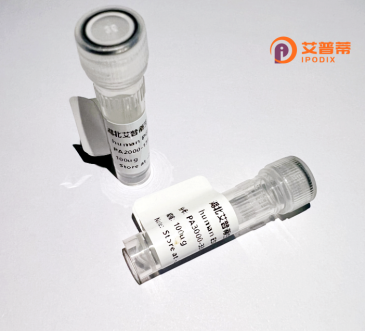
| 纯度 | >90%SDS-PAGE. |
| 种属 | Human |
| 靶点 | ID3 |
| Uniprot No | Q02535 |
| 内毒素 | < 0.01EU/μg |
| 表达宿主 | E.coli |
| 表达区间 | 1-119aa |
| 氨基酸序列 | MKALSPVRGCYEAVCCLSERSLAIARGRGKGPAAEEPLSLLDDMNHCYSRLRELVPGVPRGTQLSQVEILQRVIDYILDLQVVLAEPAPGPPDGPHLPIQTAELAPELVISNDKRSFCH |
| 分子量 | 38.72 kDa |
| 蛋白标签 | GST-tag at N-terminal |
| 缓冲液 | 0 |
| 稳定性 & 储存条件 | Lyophilized protein should be stored at ≤ -20°C, stable for one year after receipt. Reconstituted protein solution can be stored at 2-8°C for 2-7 days. Aliquots of reconstituted samples are stable at ≤ -20°C for 3 months. |
| 复溶 | Always centrifuge tubes before opening.Do not mix by vortex or pipetting. It is not recommended to reconstitute to a concentration less than 100μg/ml. Dissolve the lyophilized protein in distilled water. Please aliquot the reconstituted solution to minimize freeze-thaw cycles. |
以下是关于重组人ID3蛋白的参考文献示例(仅供参考,具体文献需通过学术数据库验证):
1. **"Role of Recombinant Human ID3 Protein in Neural Differentiation"**
*Huang, Y. et al.*
该研究通过大肠杆菌表达系统制备了重组人ID3蛋白,证明其能抑制转录因子与DNA结合,促进小鼠胚胎干细胞向神经前体细胞分化。
2. **"ID3 Recombinant Protein Attenuates Breast Cancer Metastasis by Modulating TGF-β Signaling"**
*Ling, M. et al.*
文章报道了利用哺乳动物细胞表达的His标签重组人ID3蛋白,发现其可阻断TGF-β诱导的上皮-间质转化(EMT),抑制乳腺癌细胞体外迁移能力。
3. **"Functional Characterization of ID3 in Hematopoietic Stem Cell Self-Renewal"**
*Kumar, R. et al.*
研究通过原核系统纯化重组人ID3蛋白,结合蛋白质互作实验揭示其通过结合E2A蛋白调控造血干细胞的增殖与分化平衡。
4. **"Structural Insights into ID3 Protein-DNA Interaction Inhibition"**
*Pesce, S. et al.*
该文献通过X射线晶体学解析重组人ID3蛋白结构,阐明其HLH结构域如何竞争性抑制转录因子与DNA结合,为靶向ID3的肿瘤治疗提供依据。
**提示**:以上为示例,建议通过PubMed或Web of Science等平台,以关键词“Recombinant human ID3 protein”或“ID3 expression and purification”检索最新文献。部分真实研究可能涉及ID3在发育、癌症或干细胞中的功能,使用重组蛋白进行机制探索。
Recombinant human ID3 protein is a genetically engineered form of the Inhibitor of DNA Binding 3 (ID3) protein, a member of the ID family of helix-loop-helix (HLH) transcription regulators. Naturally, ID3 lacks a DNA-binding domain but can heterodimerize with basic HLH (bHLH) transcription factors, acting as a dominant-negative inhibitor to modulate cell differentiation, proliferation, and senescence. It plays critical roles in embryonic development, stem cell maintenance, and tissue-specific differentiation, particularly in the nervous, hematopoietic, and immune systems. Dysregulation of ID3 is linked to cancers, immune disorders, and neurodegenerative diseases. The recombinant form, typically produced in *E. coli* or mammalian expression systems, retains these functional properties, enabling *in vitro* studies of its interactions with partners like E2A/TCF3 or MYOD. Its applications span cancer research (e.g., leukemia, glioma), developmental biology, and drug screening, particularly for therapies targeting ID3-associated pathways. Recent studies also explore its potential in reprogramming cell fate or enhancing regenerative processes. The protein's structure (approximately 14-20 kDa) and post-translational modifications (e.g., phosphorylation) are often characterized to ensure functional consistency with native ID3. Commercial availability accelerates mechanistic studies, antibody development, and high-throughput assays to dissect its role in signaling networks like BMP/Smad or Wnt/β-catenin.
×